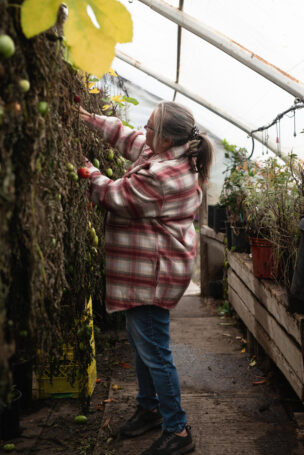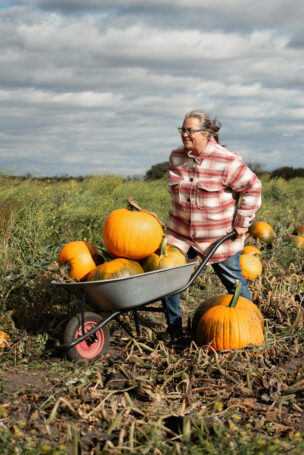December 12, 2023
Edmonton’s farm-to-table scene is getting creative in response to climate change
When you visit RGE RD, the one thing you can be certain of is an expertly prepared meal made with locally-sourced ingredients.
With over 30 suppliers all located within northern and central Alberta, the farm-to-table restaurant is committed to using ingredients sourced no more than a few hours outside the city limits. That dedication to in-season ingredients also means that what exactly makes it onto the menu isn’t a sure thing — you never know when a favourite dish might have a fresh spin or a new creation might make a guest appearance.
“We have a saying around here that the farm dictates the menu,” says Chef Blair Lebsack, an Edmonton Community Foundation donor who started RGE RD with his partner Caitlin Fulton in 2013. “If [the farms] tell us that the corn is amazing for the next three weeks, we quickly hop into lots of dishes that have corn in them. If they tell us that the fennel is amazing, that’s where we go with it.”
A result of that dialogue is that the farms growing and raising RGE RD’s ingredients aren’t suppliers as much as they are partners. Layered onto the fact that RGE RD’s partners are mostly small and family-owned farms, it means that the restaurant is especially sensitive to the impact of climate change on farmers’ ability to produce certain ingredients.
“We’ve definitely had bad years where the farmers tell us that they got half the harvest they thought they were going to,” says Lebsack. “It used to always be that farmers were trying to get their crops off in the end of September or early October, and now you can see them getting their crops off earlier because the weather is just so different.”

The concerns shared with Lebsack are indicative of a wider trend regarding Alberta’s changing climate. According to Environment and Climate Change Canada, Alberta has warmed by about 1.9 degrees since the 1960s. And while the province is known to cycle through all four seasons in the space of an afternoon, the growing unpredictability of Alberta’s climate has become increasingly worrisome.
In 2019, for example, the Edmonton area experienced its driest ever summer and wettest ever spring on record, all in the space of the same year. That goes without mentioning the impacts of the warming climate on the province’s intense wildfire seasons.
“It makes a huge difference, because the window of when you can plant and when you can harvest is changing every year,” says Tam Andersen, farmer and owner of Prairie Gardens and Adventure Farm.
“Usually your wettest year is followed by the driest year and then it might be on a 10, 25, 50 or a 200-year cycle. But those one-in-a-century cycles are coming every five years now, not every 100 years. So it’s making it a gamble every time you buy seed.”
In light of those warming trends, the federal government recently redesignated the Edmonton area from a Zone 3 to a Zone 4 plant hardiness zone. Practically, that means the region is now suitable for plants that couldn’t typically withstand the coldest Alberta winters.
For farmers accustomed to growing single crops according to predictable growing seasons, those changes are a small but worrying shift towards a more uncertain future. But like her friends at RGE RD — Prairie Gardens is one of the restaurant’s oldest and longest suppliers — Andersen and her team are responding to that change by being flexible and creative.
“We’re experimenting with new crops,” Andersen says, describing her team’s approach to the region’s warming climate. “This is the second year we’ve successfully grown watermelon up in Edmonton, which is kind of unheard of. We’re also actively looking at other crops and planting crops in the shoulder seasons, so things that grow really quickly and have a 35 or 40-day life span.”

When Andersen talks about experimenting with growing blue pumpkins, dwarf nectarines, blackberries and Chicago fig trees — the latter is an especially ambitious project that involves growing the trees year-round under cover — she says it with the playful smile of a tinkering scientist. But beyond all the fun she’s having exploring the region’s changing growing season, there are also tangible benefits to her flexible approach.
“Changes in the natural environment are certainly a big threat, but with that is an opportunity for adaptation,” says Dr. Henry An, a professor in the University of Alberta Faculty of Agriculture studying agricultural technology. “Some people don’t like the word adaptation because it feels as if you’re giving up on climate change as opposed to trying to slow it down or stop it. But if we can’t slow it down, then we have to adapt.”
“You can switch out certain crops and grow other things,” An adds, discussing some of those potential adaptation strategies. “One angle would be more drought tolerant crops or crops more resistant to large variations in temperature.”
At Prairie Gardens, adaptation means pushing the envelope of what’s typically grown in the province, while at RGE RD, it means promoting sustainability inside and outside the restaurant.“We own a butcher shop, but we still say you should eat less meat,” Lebsack mentions, explaining his own approach to valuing quality ingredients over pure consumption. Ultimately, both are part of a movement to shrink the distance from the farm to the table and maybe help save the planet in the process.
“[Our suppliers] definitely don’t just think of this year and how they can make the best for now,” Lebsack says, speaking about the inspiration he draws from farmers like Andersen. “When you talk to them, you understand that you can’t just think of what’s on your plate tomorrow. You have to think of how things are going to be affected next year and the year after.”
This story comes from the Winter 2023 edition of Legacy in Action. Read the full magazine.